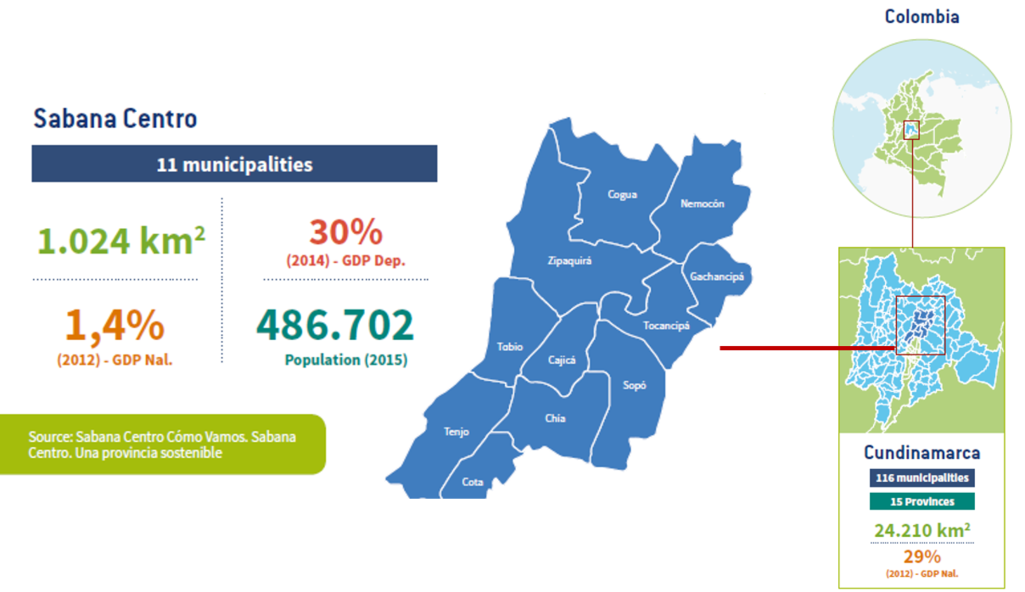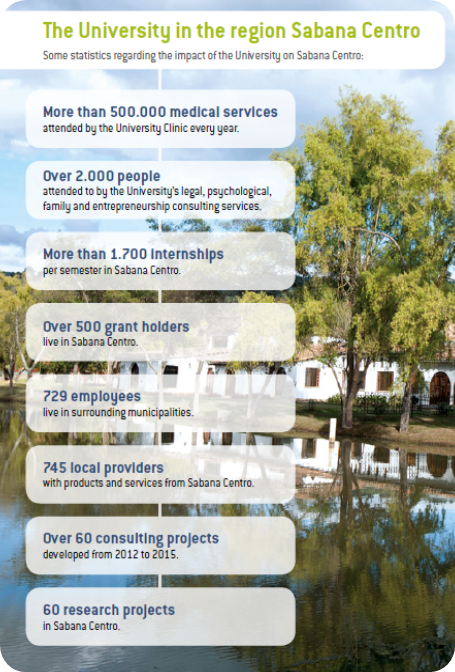Regional Observatory
The action plan proposed by the project "Sabana Centro, a sustainable province" acknowledged the Province difficulty when accessing and managing systematic and reliable information that enables the region permanent analysis of its problems and its decision-making processes. Facing this reality, the University decided to work on the construction of a regional observatory able to provide permanent monitoring. It was possible thanks the monitoring quality life model implemented by several Colombian cities, through the "how are we doing?” (¿Cómo Vamos?) methodology.
The observatory’s methodology includes the evaluation of various life quality elements from an objective and subjective dimensions. The objective dimension monitors outcome and impact indicators related to public actor’s management; meanwhile the subjective dimension follows up perception indicators that account for the public opinion about some of their daily life aspects.
The aforementioned model deals with: the people's assets (education, health, labor market, security and coexistence), habitat (housing, public services, environment, mobility), culture and citizen responsibility, good governance and economic development and competitiveness.
The University reported the model outcomes in 2016, in the first Quality of Life Report, which presents a baseline of the main researched aspects, so far, resulting in a permanent monitoring tool for the Sabana Centro minicipalities.
Quality of Life Report - 2014-2015 Baseline
Sustainable Sabana
“Sustainable Sabana” it´s the Universidad de La Sabana’s biggest bet towards sustainability on its influence area. This program started in 2012 as a regional planning exercise, defining an action plan for the region where the institution is located, by identifying the main projects that should be executed regarding infrastructure, public services, environment, and partnerships. This action plan aimed at guaranteeing the province’s responsible growth and also, strengthening its local and nationwide competitiveness.
From this first prospective exercise, the University started a regional observatory that aimed to monitoring the indicators that affect Sabana Centro´s population quality of life and the competitiveness of its municipalities. That is how Universidad de La Sabana had the chance to carry out a more assertive, efficient and responsible intervention on its influence area; and as a result, the University has had a lot of research projects, social intervention and academic events, that allowed the institution to keep an ongoing dialogue with local third parties as well as with the different realities from the province.

The Province Sabana Centro
Sabana Centro is one of the provinces that comprises the region Bogotá-Cundinamarca; it includes the following municipalities: Chía, Cota, Cajicá, Cogua, Gachancipá, Nemocón, Sopó, Tabio, Tenjo, Tocancipá y Zipaquirá. This territory gathers 22% of the population from Cundinamarca department as well as 30% of the department’s Gross Domestic Product (GDP). It is also part of the Andes Mountain Range and it has got strategic ecological systems like Bogotá River and two of the Colombia’s moorland complexes. Likewise, Sabana Centro has got a strategic geographical location: It is very close to Bogotá and at the same time it connects this capital city to the northern Caribbean region; and it also has a rich cultural, historical, and natural heritage for the country. These conditions have allowed the development of diverse economic activities such as industry, tourism, construction of residential units and a growing offer of higher and tertiary education.
Betting for a joint planning of the territory
“Sabana Centro, a sustainable territory” project rises up when the Inter-American Development Bank (IADB) bring to Colombia the Emerging and Sustainable Cities Initiative (ESCI) through a financial institution called Findeter, that implemented it as the Sustainable and Competitive Cities (SCC) program, to contribute to the orderly growth of medium-sized cities; guaranteeing a sustainable development with job opportunities, education access, safety for their citizens, and the efficient use of natural resources.
This project established the begining of a joint venture among municipalities, private and social third parties, and became a pioneering initiative for the region. The traditional ESCI methodology for medium-sized cities takes into account four dimensions for the effective intervention of the territory: The environmental sustainability and climate change; the urban dimension; the economic and social dimension; and the financial sustainability and governance. The application of this adapted model on 11 small towns implied creating a new dimension called “Regional Sustainability” to measure and understand more appropriately the interrelated dynamics among the municipalities, generating a new model which is applicable to other regions in Colombia or worldwide.
“Sabana Centro, a sustainable territory” project discover this region’s environmental and economic potential to support Bogotá’s productive system; and evidence the region’s need to establish regional strategic alliances, to improve tax collection, as well as the implementation of financial instruments that increase resources to consolidate an infrastructure for competitiveness, multidimensional territorial management, and the access and management of information for decision takers. The project concluded by identifying 48 projects (worth approximately COP$1,4 billion) to guarantee the competitiveness and sustainability of Sabana Centro in the long term.
Social Responsibility of the University in the territory:
◇ TECHNICAL ASSISTANCE
Consulting to public and private parties from the region
- Development of projects and social intervention in municipalities.
- University’s legal, psychological, family and company consulting services.
◇ JOINT TECHNICAL WORK
Interinstitutional working sessions with local authorities, third parties from the social and private sector to reflect about regional issues related to:
- Health
- Education.
- Peacebuilding
- Environment
◇ TRAINING
Development of training programs for civil servants in the municipalities
- Peacebuilding management skills
- Urban planning and statistics management
- Community health leaders.
◇ INTERACTION SABANA CENTRO-BOGOTÁ
Development of activities that promote the articulation of the capital city and Sabana Centro.
- Creation of the Mobility unit analysis for Sabana Centro-Bogotá
- Participation in the Territorial Integration Committee
- Events development: working sessions and interinstitutional projects
◇ EVENTS
Development of activities that put Universidad de La Sabana on the map as a leading center of thought.
- Bogotá region growth
- Territorial integration
- Territorial water management
- Regional mobility
◇ RESEARCH PROJECTS
Research projects focused on the region’s challenges:
- Early childhood and adolescence care
- Mobility and infrastructure
- Improvement of educational quality
- Environmental sustainability
- Peacebuilding



